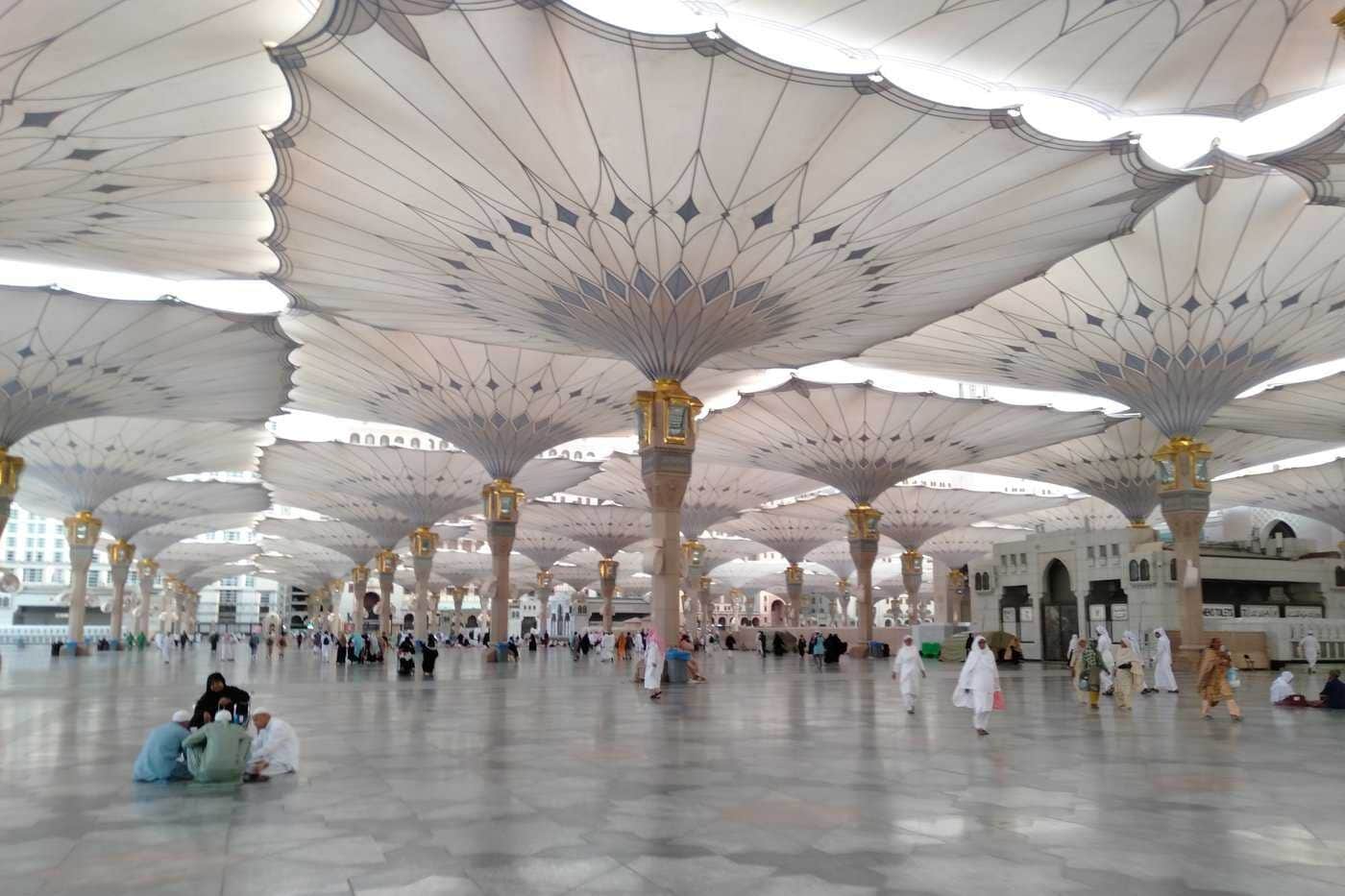
Imagine a mosque so sacred a single prayer within it outweighs a thousand elsewhere.
Masjid Al-Nawabi, the Prophet’s Mosque, holds a profound place in Islamic history.
Built by the Prophet Muhammad (peace be upon him) himself, it evolved from a simple structure into a magnificent architectural marvel.
Uncover the secrets of Masjid Al-Nawabi, and deepen your understanding of its significance in the hearts of Muslims worldwide.
Let’s embark on a journey through its rich history, from its humble beginnings to its awe-inspiring present…
Absolutely! Here’s Section 1 of the blog post, focusing on the humble beginnings of Masjid Al-Nawabi:
The Humble Beginnings
Masjid Al-Nawabi’s origin story is one of both simplicity and profound generosity. The land it stands upon was once a humble date-drying yard, partially used as a burial ground.
It belonged to two young orphan brothers, Sahl and Suhayl. When the Prophet Muhammad (peace be upon him) arrived in Medina, they offered him the land as a gift.
However, the Prophet (PBUH) insisted on paying a fair price, demonstrating his commitment to justice and respect for ownership.
Built on Piety: “This mosque of mine is founded on piety“ (al-Taqwa). (Sahih al-Bukhari 30)
The Construction
With the land secured, the construction of the first Masjid Al-Nawabi began in 622 AD. In stark contrast to the grandeur it possesses today, this initial structure was remarkably simple:
- Open-air enclosure: The mosque had no roof, merely walls of mudbrick to define its boundaries.
- Palm-trunk Pillars: Rows of palm trunks held up a roof made of palm fronds.
- Earthen floor: Pebbles and sand covered the ground.
The Prophet’s (PBUH) Participation
What makes Masjid Al-Nawabi’s construction extraordinary is the Prophet Muhammad’s (PBUH) own involvement. He worked alongside his companions, carrying bricks and stones, emphasizing the shared labor of love and community spirit that birthed this sacred mosque.
Key Points:
- Masjid Al-Nawabi arose from an act of generosity met with the Prophet’s (PBUH) unwavering sense of fairness.
- Its original form embodied the simplicity and humility central to early Islam.
- The Prophet’s own participation underscores the mosque’s significance and the sense of unity it fostered.
Protection from Dajjal: “Medina is a sanctuary from the Dajjal (Antichrist). It has seven gates, with two angels at each gate.” (Sahih al-Bukhari 1877)
The Formative Years and Early Expansions
Masjid Al-Nawawi began in 622 CE as a simple, rectangular-shaped mosque.
The Prophet Muhammad (peace be upon him) actively participated in its construction alongside his Companions.
The open-air structure featured mudbrick walls defining its perimeter, including the initial west wall. Palm trunks supported a roof of palm leaves, and the earthen floor was covered in pebbles.
The growing Muslim community in Medina necessitated expansion.
The third caliph, Uthman (RA), undertook a significant renovation of the mosque while preserving its core rectangular shape.
The original materials were improved; the west walls and other perimeter walls were rebuilt with carved stone, while teak wood replaced the palm-trunk columns.
This expansion of Masjid Al-Nawabi signified its rising importance in the early Islamic world.
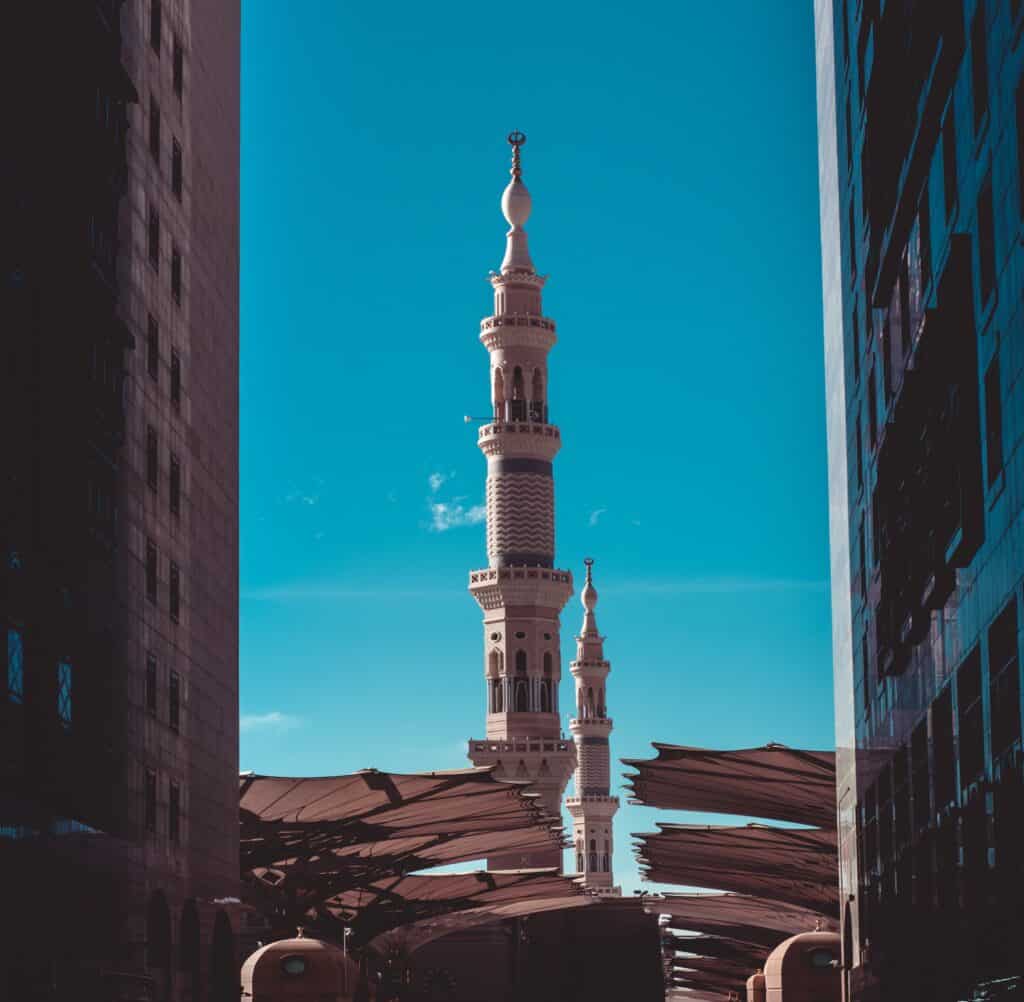
Key Points
- Masjid Al-Nawabi’s original design reflects the core values of early Islam: simplicity, unity, and a focus on worship.
- Early expansions addressed practical needs and underscored the mosque’s increasing centrality to the Islamic community.
Masjid Al-Nawabi as a Center of Islamic Life
Masjid Al-Nawabi was far more than a place of prayer. It became the beating heart of the newly established Islamic society in Medina, serving as a vibrant hub for various aspects of life.
Forgiveness of Sins: “Whoever performs forty prayers in my Mosque, not missing a prayer, will be granted exemption from the Fire, and exemption from punishment and hypocrisy.” (Musnad Ahmad, 11647. Classified as Sahih)
Beyond Prayer
Here’s how the mosque went beyond a place of worship:
- Community Center: Consultations, announcements, and the welcoming of delegations took place within its walls.
- School: The Prophet (PBUH) and his companions taught the fundamentals of Islam, fostering the Suffa – a space dedicated to learning.
- Court of Law: The Prophet (PBUH) would dispense justice, resolve disputes, and clarify legal rulings from his position within the mosque.
Dying in Medina: “Whoever can die in Medina, let him do so, for I will intercede for whoever dies there.” (Sunan al-Tirmidhi 3917. Classified as Sahih)
The Prophet’s (PBUH) Home
Adjacent to the mosque were the Hujarat (humble quarters) where the Prophet (PBUH) resided with his wives. The mosque wasn’t merely a walk away, it was integrated into his domestic life.
The Rawdah
A special section between the Prophet’s (PBUH) tomb and his original pulpit is known as the Rawdah. It’s considered a place of immense blessings.
The Prophet (PBUH) said: “Between my house and my pulpit is a garden from the gardens of Paradise” (Sahih al-Bukhari 1196).
Key Points
- Masjid Al-Nawabi transcended the concept of a modern-day mosque, embodying the holistic nature of early Islam where faith and community were inseparable.
- The Prophet’s (PBUH) proximity to the mosque underscores its central role in guiding his leadership and the development of Islamic society.
- The Rawdah exemplifies how places within the mosque acquired deep spiritual significance.
Expansions Through the Ages
The mosque began from its humble beginnings, Masjid Al-Nawabi has witnessed transformations that reflect the faith, resources, and architectural styles of different Islamic eras.
The Rashidun Caliphs (632-661 CE)
- Umar’s Expansion (RA): As the Muslim community grew, the first Caliph, Abu Bakr (RA), didn’t expand the holy mosques due to other pressing priorities. However, the need became critical during Caliph Umar’s (RA) reign. He purchased surrounding houses and demolished them to enlarge the mosque.
- Uthman’s Renovation (RA): Caliph Uthman (RA) rebuilt the walls with carved stones, replaced the palm-trunk columns with stone, and used teak wood for the roof. He also introduced pebbles to cover the open courtyard.
The Umayyad Era (661-750 CE)
- Al-Walid I’s Transformation: The Umayyad Caliph Al-Walid I undertook the first significant expansion, adding more land and incorporating luxurious features. Most notably, the Prophet’s tomb became enclosed within the mosque structure.
- Introduction of the Minarets: The Umayyads built the first four minarets, marking a shift in mosque architecture.
The Abbasid Era (750-1258 CE)
- Successive Expansions: A series of Abbasid caliphs expanded and renovated Masjid Al-Nawabi.
- The Green Dome (Debated): While popularly associated with the Mamluks, some sources suggest the construction of the iconic green dome commenced during the Abbasid era.
The Mamluk Era (1250-1517 CE)
- Restoration After Fires: The mosque suffered several fires, and the Mamluks played a pivotal role in rebuilding and beautifying it.
- Kutub Khana: They established a unique library within the mosque, underscoring its scholarly role.
The Ottoman Era (1517-1918 CE)
- Major Reconstruction: Under the Ottomans, Masjid Al-Nawabi underwent extensive reconstruction and their distinctive architectural style became evident.
- Decorative Flourishes: The Ottoman Sultan Suleiman introduced intricate calligraphy, marble paneling, and colorful tilework.
Key Points
- Each ruling dynasty left its architectural imprint on Masjid Al-Nawabi, transforming it over time.
- Expansions reflected a need for space and shifts in artistic expression and resources.
- Despite changes, the essence of the Prophet’s (PBUH) original vision was preserved in its core spaces.
Absolutely! Section 4 highlights the contributions of the Saudi era and the mosque’s current state.
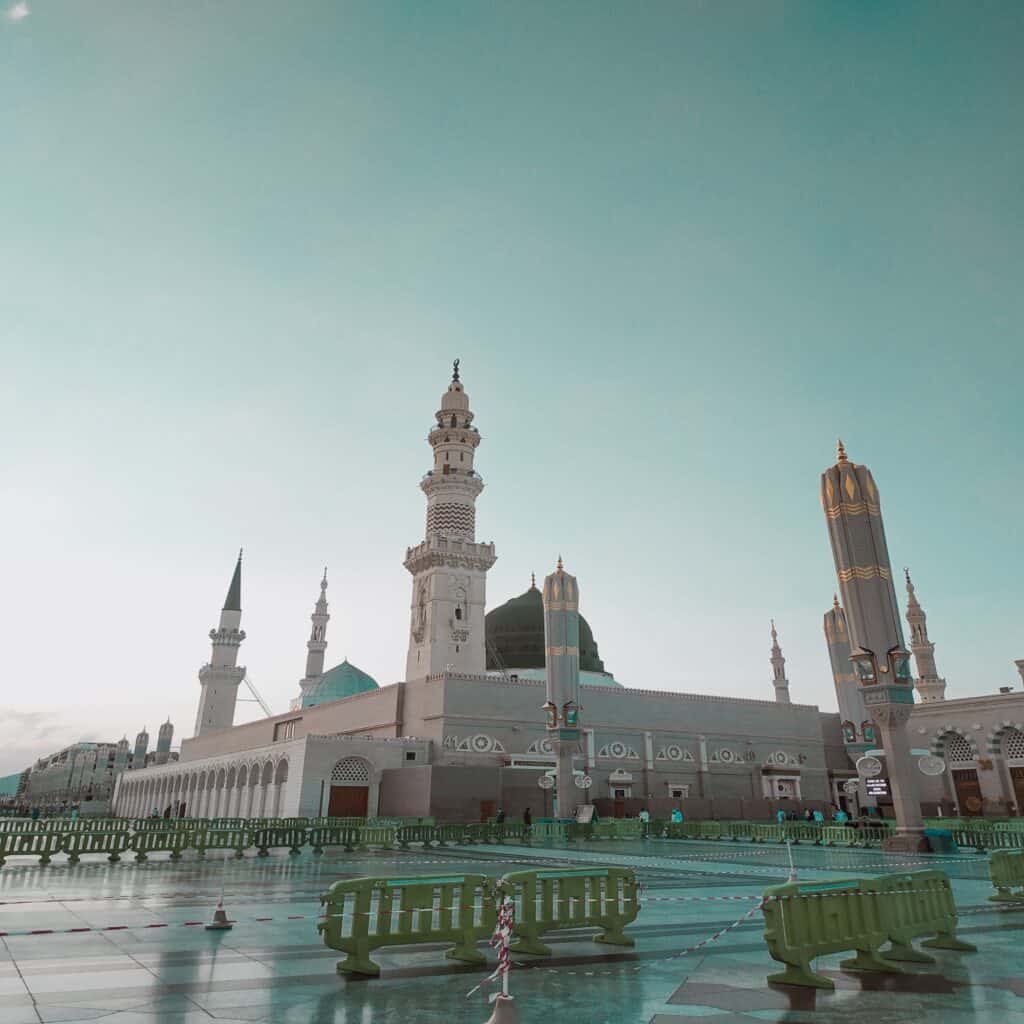
The Modern Era: Saudi Expansions
The Saudi era marked a period of unprecedented transformation for Masjid al Nabawi into new rectangular shaped mosque. Ambitious expansion plans were initiated by a desire to accommodate the ever-growing number of pilgrims and provide the utmost comfort and introducing new steel covered dome.
King Abdulaziz’s Grand Vision:
The first Saudi King, Abdulaziz Al Saud, envisioned a Masjid Al-Nawabi that reflected the glory of Islam while ensuring the best worshippers’ experience. The first Saudi expansion began in 1951, aiming to increase the mosque’s capacity significantly.
Modernization and Technological Advancements:
- A Shift Towards Comfort: The Saudi era saw the introduction of modern amenities that dramatically transformed the pilgrim experience:
- Electricity was followed by the installation of fans and, later, air conditioning.
- Marble floors replaced pebbles, offering a smoother surface.
- Advanced sound systems for sermons and crowd management.
Ongoing Expansion:
The Saudi commitment to the two holy mosques has continued through successive rulers. Expansions further enlarged the space, and modern architectural styles became evident.
Even today, efforts continue to increase the mosque’s capacity and accommodate the constantly increasing number of pilgrims.
Key Points:
- Saudi expansions have focused on pilgrim comfort and capacity without sacrificing the mosque’s spiritual significance.
- Technological advancements integrated seamlessly, enhancing the overall experience.
- Masjid Al-Nawabi is a testament to the ongoing dedication of Saudi leadership in serving Islam and its followers.
Masjid Al-Nawabi in the Quran and Hadith
The virtues and significance of Masjid Al-Nawabi aren’t merely part of historical legacy; they have a firm foundation in Islamic scripture. Here’s how the Quran and Hadith illuminate its special place:
Virtue of Prayer
- The Quran, in Surah At-Tawbah, mentions that the mosque is founded upon piety. This underscores its spiritual essence as a place of righteous devotion.
- The Prophet Muhammad (peace be upon him) said, “A prayer in my mosque is better than a thousand prayers anywhere else, except al-Masjid al-Haram…” (Sahih al-Bukhari 1133). This hadith clearly emphasizes the immense reward associated with prayer in Masjid Al-Nawabi.
Pilgrimage
- While Hajj centers around Mecca, many pilgrims extend their journey to Medina to visit Masjid Al-Nawabi. The Prophet (PBUH) said: “He who performs Hajj and does not visit me has indeed treated me unkindly.” [Al-Mu’jam al-Awsat 3731]
- Even without the obligation of Hajj, Muslims perform Umrah (the lesser pilgrimage), often including a visit to Masjid al-Nawabi as part of their sacred journey.
- “Do not travel except to three Mosques: Al-Masjid Al-Haram, this Mosque of mine, and Al-Masjid Al-Aqsa (Jerusalem).” (Sahih al-Bukhari 1189)
Specific Places of Significance
- The Rawdah: As mentioned earlier, this holds a special place: “Between my house and my pulpit is a garden from the gardens of Paradise” (Sahih al-Bukhari 1196).
Key Points
- The Quran and Hadith explicitly highlight the spiritual rewards of praying and visiting Masjid Al-Nawabi.
- It holds a unique place in the hearts of Muslims and is deeply intertwined with the acts of pilgrimage.
- Specific areas within the mosque have acquired profound significance based on the words of the Prophet (PBUH).
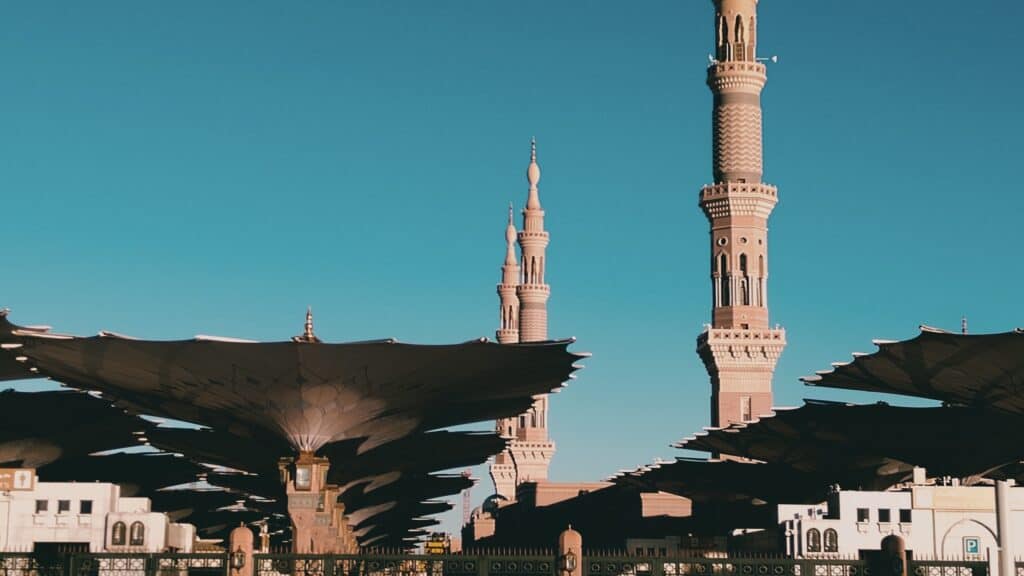
Notable Features of Masjid Al-Nawabi
Over the centuries, Masjid Al-Nawabi has evolved into a complex rich with architectural details and elements of spiritual importance. Here’s a look at its most iconic features:
- The Green Dome: The most recognizable symbol of Masjid Al-Nawabi, it stands above the tomb of the Prophet Muhammad (peace be upon him), Abu Bakr (RA), and Umar (RA). Its history is fascinating:
- Not initially green – it was painted white and other colors before adopting its distinctive hue.
- Repainted in 1837, inspiring the name “Green Dome.”
- The Minarets: Masjid Al-Nawabi boasts ten minarets, with the oldest dating back to the Ottoman era. They provide a visual frame for the mosque and assist in the functional role of calling for prayer.
- The Mihrab: The mihrab indicates Mecca’s direction (Qibla). Masjid Al-Nawabi has several prayer niches, each reflecting the architectural styles of its era. The main mihrab showcases intricate Ottoman design and calligraphy.
- The Ottoman Pulpit (Minbar): A masterpiece of craftsmanship, this beautifully carved wooden pulpit is a testament to the artistry of the Ottoman period.
- Other Features:
- Expansive courtyards with retractable umbrellas for shade.
- Marble floors adorned with geometric patterns.
- Extensive library with Islamic manuscripts and scholarly resources.
Key Points
- The Green Dome acts as the most powerful visual symbol, reminding visitors of the Prophet’s (PBUH) presence.
- Each feature acts as a historical layer, reflecting the contributions of different eras.
- The blend of functionality (minarets, mihrab) and artistry highlights the Islamic focus on both utility and beauty.
Conclusion
The story of Masjid Al-Nawabi is a testament to the enduring power of faith. From its simple beginnings as a humble structure built by the Prophet Muhammad (peace be upon him) himself, it has evolved into an awe-inspiring architectural marvel.
Each expansion and every renovation is a reflection of both the passage of time and the unwavering devotion of Muslims throughout the centuries.
Its walls hold more than just bricks and mortar – they echo with centuries of prayers, learning, and acts of unwavering faith. Within its courtyards, pilgrims from every corner of the world gather in a profound display of unity.
If you ever have the fortune to stand within Masjid Al-Nawabi, let the weight of its history wash over you. Imagine the Prophet (PBUH) walking these grounds and picture the countless souls who have found solace in its embrace.
Whether you experience it in person or simply through exploration, Masjid Al-Nawabi stands as a testament to the rich legacy of Islam and its profound place in the hearts of believers worldwide.
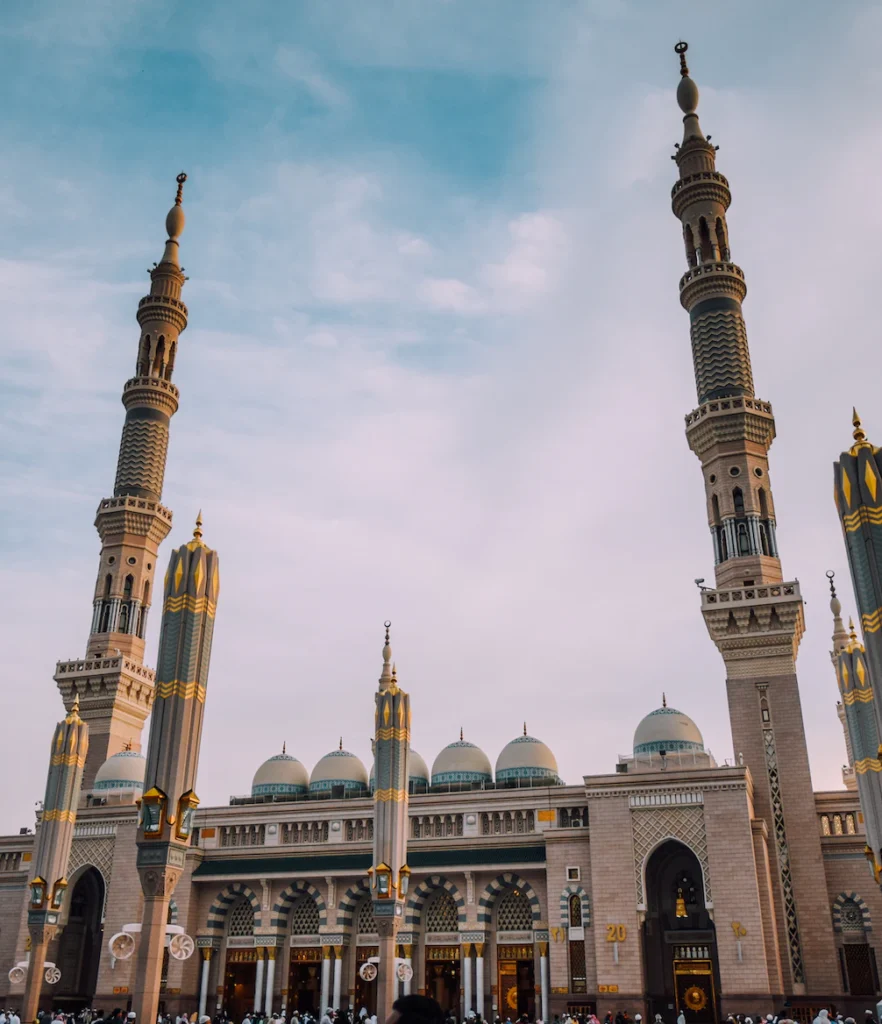
Frequently Asked Questions
When was Masjid Al-Nawabi built?
Construction of the original Masjid Al-Nawabi commenced in 622 CE upon the Prophet Muhammad’s (PBUH) arrival in Medina. The mosque has undergone multiple expansions and renovations throughout the centuries.
Who built the original Masjid Al-Nawabi?
The Prophet Muhammad (PBUH) himself actively participated in building the first, simple structure of Masjid Al-Nawabi alongside his Companions. It was built on land owned by two young orphans.
Why is Masjid Al-Nawabi important?
Masjid Al-Nawabi is the second holiest mosque in Islam. The Prophet (PBUH) is buried here, and it holds the garden of Paradise (The Rawdah). Prayer here is more rewarding than in most other mosques.
What was Masjid Al-Nawabi originally made of?
The Prophet’s Mosque was initially a simple structure with mudbrick walls, palm-trunk columns, and a roof made of palm fronds. The floor was plain earth covered in pebbles.
How many expansions has Masjid Al-Nawabi had?
Masjid Al-Nawabi has undergone continuous expansions throughout history, with major ones undertaken by the Rashidun Caliphs, the Umayyads, Abbasids, Mamluks, Ottomans, and the modern Saudi state.

